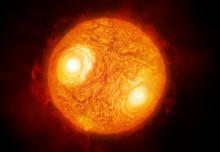Listen to today's episode of StarDate on the web the same day it airs in high-quality streaming audio without any extra ads or announcements. Choose a $8 one-month pass, or listen every day for a year for just $30.
You are here
Moon and Antares
Stars are funny things. Despite what you might expect, the biggest stars are among the coolest — at least on the outside. On the inside, they’re the hottest.
An example is Antares, the brightest star of the scorpion. It’s close below the Moon at nightfall.
It’s a bit harder to see its color when the Moon is around, but Antares shines bright orange. That tells us that its surface is fairly cool — more than 4,000 degrees cooler than the surface of the Sun.
But Antares is many times the Sun’s mass. That classifies it as a supergiant. The powerful gravity of such a heavy star squeezes its core tightly. And that jacks up the core’s temperature. So the heart of Antares is tens of millions of degrees hotter than the heart of the Sun.
The heat on the inside is the reason the star’s outside is so cool. The hot core produces radiation that pushes on the star’s outer layers of gas. That causes them to puff outward. As they expand, they get less dense. And as the density of the gas drops, so does its temperature.
A cooler gas emits less overall energy than a hotter gas. So each square foot of Antares emits much less energy than the same area of the Sun. But the surface area of Antares is several hundred thousand times greater than the Sun’s. So overall, Antares shines perhaps 75,000 times brighter than the Sun.
Again, look for bright Antares keeping pace with the Moon throughout the night.
Tomorrow: the shorter days of yesteryear.
Script by Damond Benningfield



